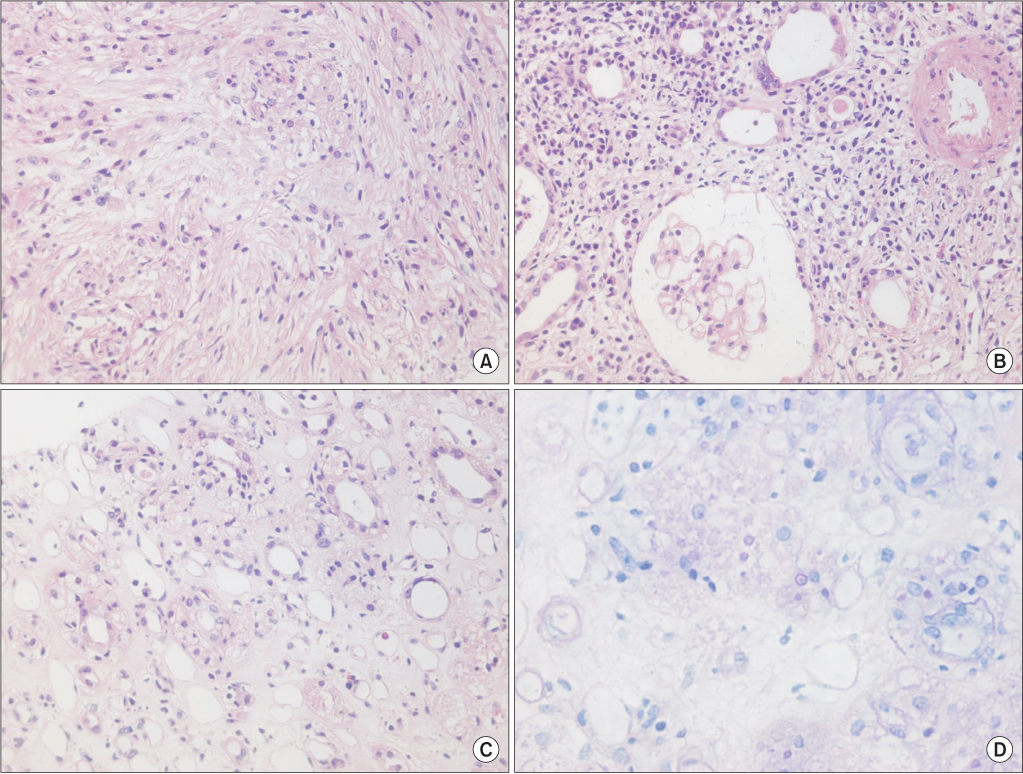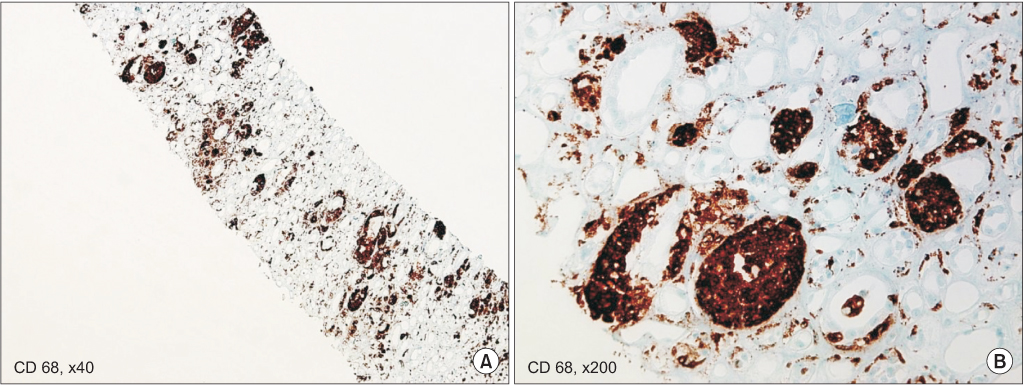Ewha Med J.
2015 Mar;38(1):36-41. 10.12771/emj.2015.38.1.36.
Renal Parenchymal Malakoplakia with Acute Interstitial Nephritis Presented with Acute Kidney Injury
- Affiliations
-
- 1Department of Internal Medicine, Yonsei University College of Medicine, Seoul, Korea. YOOSY0316@yuhs.ac
- KMID: 2171327
- DOI: http://doi.org/10.12771/emj.2015.38.1.36
Abstract
- Malakoplakia is an uncommon chronic granulomatous inflammatory disease which is associated with immunocompromised conditions such as malignancy, autoimmune disease, chronic alcohol intake, poorly controlled diabetes and long-term steroid use. Malakoplakia can occur at various sites, most commonly in the genitourinary tract including urinary bladder and the ureter. Renal parenchymal involvement is relatively uncommon, accounting for 15% of all malakoplakia. A few cases of renal malakoplakia have been reported in Korea, and only one case was accompanied by acute kidney injury. Here we report an 80-year-old female patient with renal parenchymal malakoplakia and acute interstitial nephritis presented as acute kidney injury with literature review.
MeSH Terms
Figure
Reference
-
1. Jung SJ, Kang HC, Choi JJ. Malakoplakia of the kidney extending to the descending colon in a patient with secondary adrenal insufficiency: a case report. Korean J Fam Med. 2011; 32:367–372.2. Yoon SY, Lee HJ, An JH, Kim SJ, Kim SW, Woo JH, et al. Renal parenchymal malakoplakia presenting with abscesses and hepatic extension misdiagnosed as a malignant tumor: a case report. Korean J Med. 2012; 82:764–768.3. Jo YI, Yoo TS, Heo WM, Yoo JK, Jo HS, Yoo KH, et al. A case of renal malakoplakia with renal insufficiency. Korean J Med. 1996; 51:843–849.4. Keitel E, Pegas KL, do Nascimento Bittar AE, dos Santos AF, da Cas Porto F, Cambruzzi E. Diffuse parenchymal form of malakoplakia in renal transplant recipient: a case report. Clin Nephrol. 2014; 81:435–439.5. Diwakar R, Else J, Wong V, Carne A, Banerjee D, MacPhee I. Enlarged kidneys and acute renal failure: why is a renal biopsy necessary for diagnosis and treatment? Nephrol Dial Transplant. 2008; 23:401–403.6. Cho MH, Chae IY, Kim KB, Rhew HY, Hur B, Huh MH. A case of Malakoplakia with duplex kidney. Korean J Urol. 1989; 30:250–255.7. Hong JH, Kim HJ, Kim CS, Ahn TJ, Ahn TY, Kim KH. Malacoplakia in genitourinary tract: 2 cases. Ulsan Univ Med J. 1992; 1:212–216.8. Jung SS, Joo YS, Jin JY, Jung DR, Moon HB, Kim KH, et al. A case of renal parenchymal malakoplakia associated with E: coli empyema. Korean J Infect Dis. 1993; 25:277–281.9. Kim SE, Noh TW, Kown KW, Jeong HJ, Kim YS, Kim SI, et al. Malakoplakia in a renal allograft: a case report. J Korean Soc Transplant. 2001; 15:256–258.10. Jeong YH, Kim DJ, Kim JH, Lee HJ, Jang GD, Kim EK, et al. Bilateral renal parenchymal malacoplakia presenting as fever and acute renal failure. Korean J Nephrol. 2001; 20:530–534.11. Sung DE, Yu E, Kim CS, Ro JY. Renal malakoplakia with secondary hepatic extension: a case report. Korean J Pathol. 2003; 37:199–203.12. Tam VK, Kung WH, Li R, Chan KW. Renal parenchymal malacoplakia: a rare cause of ARF with a review of recent literature. Am J Kidney Dis. 2003; 41:E13–E17.
- Full Text Links
- Actions
-
Cited
- CITED
-
- Close
- Share
- Similar articles
-
- A Case of Acetaminophen-induced Acute Interstitial Nephritis Presenting with Acute Renal Failure
- A Case of Carbamazepine-Induced Acute Interstitial Nephritis
- A Case of Methomyl-induced Acute Allergic Tubulointerstitial Nephritis
- A Case of Mycoplasma Pneumoniae Infection Associated Acute Interstitial Nephritis
- Acute Tubulointerstitial Nephritis with Renal Failure Complicated by Typhoid Fever





